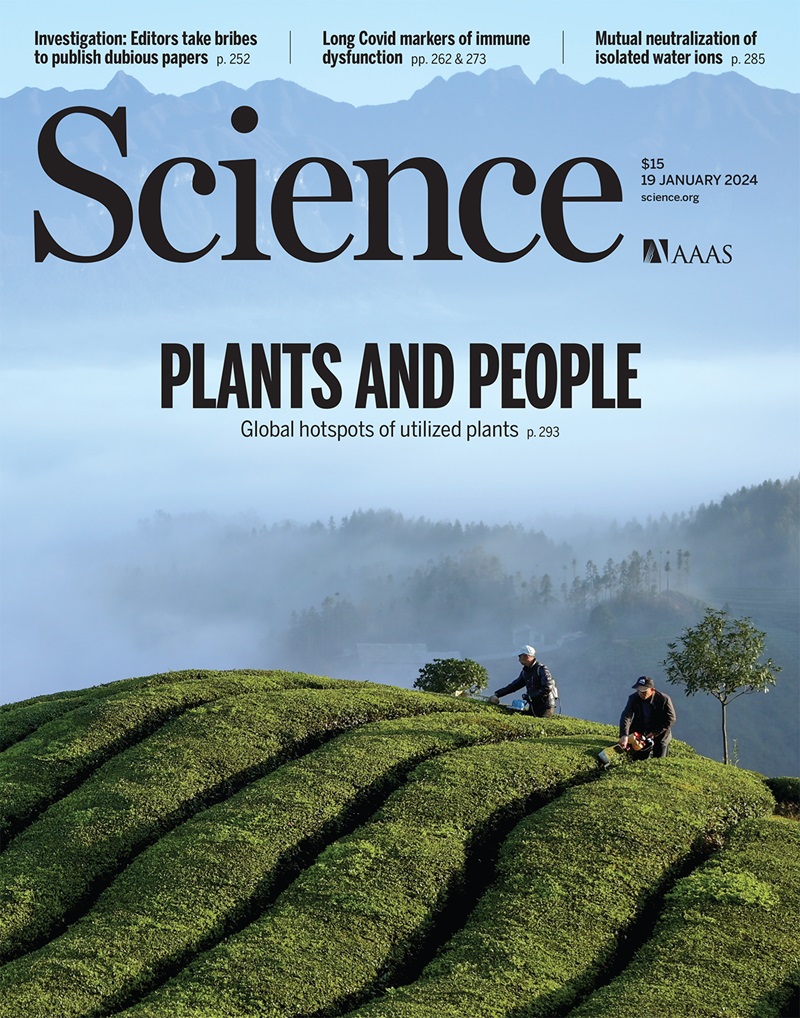Structural basis for odorant recognition of the insect odorant receptor OR-Orco heterocomplex
IF 45.8
1区 综合性期刊
Q1 MULTIDISCIPLINARY SCIENCES
引用次数: 0
Abstract
Insects detect and discriminate a diverse array of chemicals using odorant receptors (ORs), which are ligand-gated ion channels comprising a divergent odorant-sensing OR and a conserved odorant receptor co-receptor (Orco). In this work, we report structures of the ApOR5-Orco heterocomplex from the pea aphid Acyrthosiphon pisum alone and bound to its known activating ligand, geranyl acetate. In these structures, three ApOrco subunits serve as scaffold components that cannot bind the ligand and remain relatively unchanged. Upon ligand binding, the pore-forming helix S7b of ApOR5 shifts outward from the central pore axis, causing an asymmetrical pore opening for ion influx. Our study provides insights into odorant recognition and channel gating of the OR-Orco heterocomplex and offers structural resources to support development of innovative insecticides and repellents for pest control.
昆虫气味受体 OR-Orco 异构体识别气味的结构基础
昆虫利用气味受体(ORs)来检测和分辨各种化学物质,气味受体是配体门控离子通道,由不同的气味传感 OR 和保守的气味受体共受体(Orco)组成。在这里,我们报告了豌豆蚜Acyrthosiphon pisum的Ap OR5-Orco异质复合物的单独结构以及与其已知激活配体乙酸香叶酯结合的结构。在这些结构中,三个 Ap Orco 亚基作为支架成分,不能与配体结合,并保持相对不变。配体结合后,Ap OR5 的孔形成螺旋 S7b 从中心孔轴向外移动,导致离子流入的不对称孔开口。我们的研究深入揭示了 OR-Orco 异质复合物的气味识别和通道门控,并为开发创新型杀虫剂和驱虫剂提供了结构资源。
本文章由计算机程序翻译,如有差异,请以英文原文为准。
求助全文
约1分钟内获得全文
求助全文
来源期刊

Science
综合性期刊-综合性期刊
CiteScore
61.10
自引率
0.90%
发文量
0
审稿时长
2.1 months
期刊介绍:
Science is a leading outlet for scientific news, commentary, and cutting-edge research. Through its print and online incarnations, Science reaches an estimated worldwide readership of more than one million. Science’s authorship is global too, and its articles consistently rank among the world's most cited research.
Science serves as a forum for discussion of important issues related to the advancement of science by publishing material on which a consensus has been reached as well as including the presentation of minority or conflicting points of view. Accordingly, all articles published in Science—including editorials, news and comment, and book reviews—are signed and reflect the individual views of the authors and not official points of view adopted by AAAS or the institutions with which the authors are affiliated.
Science seeks to publish those papers that are most influential in their fields or across fields and that will significantly advance scientific understanding. Selected papers should present novel and broadly important data, syntheses, or concepts. They should merit recognition by the wider scientific community and general public provided by publication in Science, beyond that provided by specialty journals. Science welcomes submissions from all fields of science and from any source. The editors are committed to the prompt evaluation and publication of submitted papers while upholding high standards that support reproducibility of published research. Science is published weekly; selected papers are published online ahead of print.
 求助内容:
求助内容: 应助结果提醒方式:
应助结果提醒方式:


